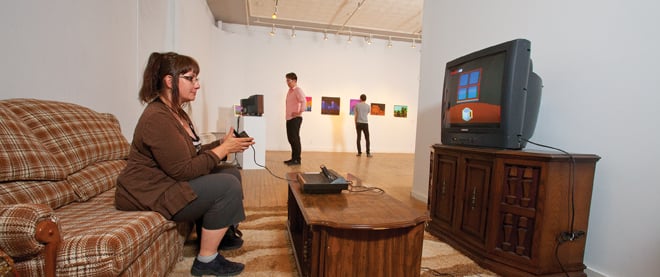Video gaming in art galleries
Atari and Game Boys find love and appreciation outside of vintage and junk shops
Photograph by Marianne Helm
Share

In one corner of the Platform Centre for Photographic + Digital Arts in Winnipeg, a brown plaid sofa set on a shaggy brown rug faces a cathode-ray tube TV, which is hooked up to a vintage Atari game console. Gallery goers are invited to sit down and play A Slow Year, designed by video game poet Ian Bogost, who is also director of the digital media program at the Georgia Institute of Technology. It hearkens back to a simpler time, when consoles didn’t have much memory to work with, so the games weren’t as frenetic as today’s. The game takes the player through the year in a meditative manner: in winter, you use the joystick to sip a cup of coffee while the sun rises outside. In summer, you take a nap under fluffy clouds and try to predict where a log floating downriver will be when you open your eyes.
“It draws its inspiration from poetry, from haiku and imagism, the idea of precision in the image,” explains Bogost, one of six artists whose work is on display at the small Winnipeg gallery until July 28. “When you program with the Atari, you have to program within these very stringent technical constraints, and I saw a connection with the material constraints of poetry.” When he takes A Slow Year to gamer conferences, players ask if it’s a real Atari. At museums, gallery-goers are reluctant to sit down and actually touch the joystick.
At Platform, the focus of the Reset: Post-Consumer Gamer Culture exhibit is on vintage consoles. Along with the blaring beeps and blips of the music, it inspires nostalgia in those who remember a childhood spent in video arcades or their best friend’s basement. “It’s contemporary art with vintage technology,” explains guest curator Skot Deeming.
After 40 years of existence, video games are ripe for artistic evaluation. In the exhibition The Art of Video Games, the Smithsonian American Art Museum in Washington celebrates commercial gaming, including iconic devices like the ColecoVision and the Commodore 64, along with the Xbox and PlayStation 3. Visitors get to play five games selected for their influence on the gaming industry: Pac-Man, Super Mario Bros., The Secret of Monkey Island, Myst and Flower.
“Within games, you’ll find illustration, painting, narrative and orchestral music. You have all of these things that we view as traditional arts, and when they’re combined, they’re greater than the whole,” explains the exhibit’s curator, Chris Melissinos.
Game-art exhibits also draw a different crowd than traditional art shows, a boon to galleries and museums trying to attract new audiences. At the Smithsonian, fans dressed as their favourite game character for the exhibit’s kickoff. Both gamers and the city’s artistic set have come out to the show in Winnipeg’s downtown core.
At Platform, Deeming (a.k.a. mrghosty), a graduate student at Toronto’s York University who studies video game development and art, seems tired of the debate over the artistic merits of the medium. “I don’t think the question is, can they be art, but how? What qualifies them as art? Where is the artistry coming from, what is the context?”
Deeming says not every mass-produced commercial game has artistic value, the same way not every Hollywood blockbuster is a masterpiece of cinematography. “There are some contemporary 3D realistic games that are striking and gorgeous. But if your interaction is limited to guns and bullets, where is the artistry?”
The gallery also features digital prints by California artist Max Capacity, who modified crude, low-resolution images from 1980s video games to create pixelated cityscapes. And Winnipeg video artist Clint Enns made a cheeky homage to Andy Warhol’s eight-hour film about the Empire State Building, but his lasts less than 15 minutes and uses footage of an art deco skyscraper from Grand Theft Auto IV.
Enns grew up playing games for fun, but sadly now when he plays it’s to generate footage for his movies. “I play them now when I want to work.”